E-Postcard #5
from Our British Isles Holiday
10/28 to 11/3/2002
Dydd da (good day) from Wales,
I know you have just received our Irish report, but since email communications are available, I thought I would send this while I can. We have just finished our eight day tour of Wales. It was to be nine days but, as we ended our last e-postcard, we were delayed a day due to high winds and waves on the Irish Sea. Not only were ferries cancelled there, coastal towns all over Ireland and Britain were closed down. When we did arrive in Wales, we saw many uprooted trees and downed power lines. The worst hit was a town we visited that had 96 mile per hour winds. Reminds me of the Muskegon winds a few years back.
Wales, like Ireland, has a long history of struggle against English domination. However, they have managed to keep their language and culture fairly intact. Also, like Ireland, all of the public signs are bilingual. The Welsh language is the language of double letters like “ll”, “ff”, and “dd”, and where the letters “y” and “w” are vowels. This makes the town names fun to try to pronounce, but difficult to read when you are trying to decide where to get off the innumerable turn-abouts (traffic circles) all over the country. My favorite so far is the town of Eglwyswrw (which we think is pronounced iglooey-SOO-roo).
Say the “w” as “oo”, the “y” as “i” in “it”, the “dd” as “th”, the “ff” as “f”, and the “f” as “v”.
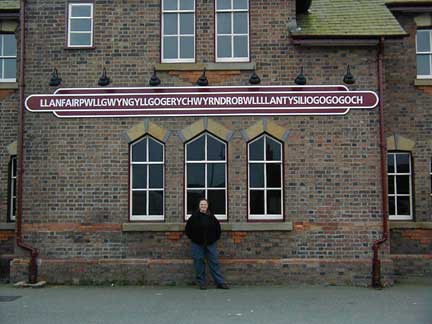 The “ll” is an “hl” which you kind of spray out (at least the foreigners do).
So try that on the following: Mynachlogddu, Ffwrwm, Lake Vyrnwy, Llaneglwys, Mynydd Myddfai, Pwllgolyw, Cymduad, and Penycym (we stayed in the last two). Welsh is supposedly a phonetic language (say what you see) but my problem is I keep seeing double! Not all of the Welsh town names were hard to pronounce. Some interesting ones were: Stepaside, Porthadog, Cheritan or Stackpole Elidor, Tavernspite, Felinde Farchog, and (for the mathematically inclined) Square & Compass.
The “ll” is an “hl” which you kind of spray out (at least the foreigners do).
So try that on the following: Mynachlogddu, Ffwrwm, Lake Vyrnwy, Llaneglwys, Mynydd Myddfai, Pwllgolyw, Cymduad, and Penycym (we stayed in the last two). Welsh is supposedly a phonetic language (say what you see) but my problem is I keep seeing double! Not all of the Welsh town names were hard to pronounce. Some interesting ones were: Stepaside, Porthadog, Cheritan or Stackpole Elidor, Tavernspite, Felinde Farchog, and (for the mathematically inclined) Square & Compass.
On our way to Caernarfon for our first night’s stay, we stopped in the town with the longest name in the world. It is Llanfairpwllgwyngyllgogerychwyrndrobwilliantysiliogogogoch (meaning St. Mary’s church in the hollow of the white hazel near the rapid whirlpool and the church of St. Tysilio by the red cave). Obviously a tourist trap, but it does keep the sign makers busy. Even the locals call it Llanfairpwll for short. (I smell smoke. Must be the spellchecker on the computer.)
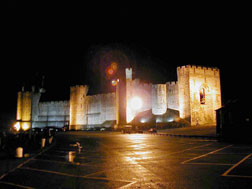
Caernarfon is a partially walled harbor town with a huge castle. In fact, the English (especially Edward II) were so afraid of a Welsh uprising that they built many of these immense stone fortresses. Wales has over 600 castles, so we have to get pretty picky about what we see. Like other medieval towns we have seen, the streets inside the walls are very narrow with tiny shops and little passages between buildings (called slips). Street names are always a delight to read. When you see street names like Chandler (candle maker), Fishmarket, Priory, Butterslip, and Hatters, you can imagine what shopping was like back then. Our Caernafon hostel was on Porth-Yr-Or (street of the golden gate) where smugglers used to bring in gold from the harbor through tunnels to the castle. The hostel basement still has a stone archway from a tunnel.
Using Caernarfon as a base, we spent several days exploring Northern Wales. A highlight was Snowdonia National Park, home of Mt. Snowdon, the highest peak in England and Wales.
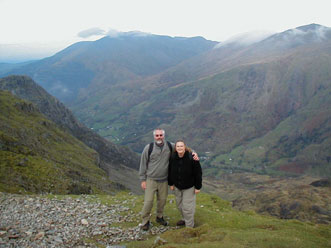 We climbed (down) Mt. Snowdon (about three-fourths of the way) after taking a small train up. One could see valleys, rivers, and lakes below (see attached photo). This whole process was almost a bust. We arrived at 10:30 a.m. to find that the next available train wasn’t until 2 p.m. Since it was drizzling, we had no intention of climbing up the mountain. So we bought advance tickets and drove around some local villages to pass the time. Although we arrived 15 minutes early for the train, every passenger seat was taken (they had oversold the seats by two). They offered to refund our money but we were beyond indignant. We had spent the day essentially waiting for the train. After appealing to several levels of bureaucracy, we were allowed to sit in the front with the brakeman (the best seats on the train). To our surprise it stopped raining and the sun even shone for a few seconds while we walked. This walk was certainly worth the wait.
We climbed (down) Mt. Snowdon (about three-fourths of the way) after taking a small train up. One could see valleys, rivers, and lakes below (see attached photo). This whole process was almost a bust. We arrived at 10:30 a.m. to find that the next available train wasn’t until 2 p.m. Since it was drizzling, we had no intention of climbing up the mountain. So we bought advance tickets and drove around some local villages to pass the time. Although we arrived 15 minutes early for the train, every passenger seat was taken (they had oversold the seats by two). They offered to refund our money but we were beyond indignant. We had spent the day essentially waiting for the train. After appealing to several levels of bureaucracy, we were allowed to sit in the front with the brakeman (the best seats on the train). To our surprise it stopped raining and the sun even shone for a few seconds while we walked. This walk was certainly worth the wait.
Every day we were in Wales it rained at least part of the day. The skies were, however, clear most nights. One night it was sprinkling and clear skies at the same time!
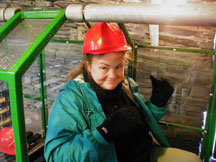 Knowing how unpredictable October weather can be, we tried to have alternative plans. This could include driving around, seeing museums and ruins with roofs, etc. One rainy day we toured a slate mine. The slate mined in Wales provided roofs for Europe until World War II and the advent of other roofing materials. A small train took us down into the mine where you could see how huge pieces of slate were blasted out and brought to the surface. Later we watched a slate splitter take an inch-thick piece and split it into eight thin sheets. So little actual usable slate results from this process that you can see sides of mountains covered with the slate wastes from the mines. When the mines closed, many villages were devastated and large groups of people emigrated.
Knowing how unpredictable October weather can be, we tried to have alternative plans. This could include driving around, seeing museums and ruins with roofs, etc. One rainy day we toured a slate mine. The slate mined in Wales provided roofs for Europe until World War II and the advent of other roofing materials. A small train took us down into the mine where you could see how huge pieces of slate were blasted out and brought to the surface. Later we watched a slate splitter take an inch-thick piece and split it into eight thin sheets. So little actual usable slate results from this process that you can see sides of mountains covered with the slate wastes from the mines. When the mines closed, many villages were devastated and large groups of people emigrated.
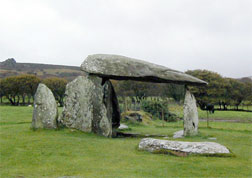
On another rainy day we hunted up a prehistoric dolmen, or rock tomb. Imagine several huge slabs of rock, maybe seven feet high, standing on end and forming three sides of a square. On top of that place one even larger rock to serve as a roof. No mortar, just balanced rock. People of importance to the tribe were buried there. We were fortunate enough to have the site to ourselves for a while. The whole feeling of the place was kind of eerie, with the gray sky threatening rain and the dolmen in a remote field, away from roads and villages. Di thinks that when abbey ruins and prehistoric stone structures are viewed in rainy weather, it just adds to the atmosphere. Tim, the photographer, would prefer the sun.
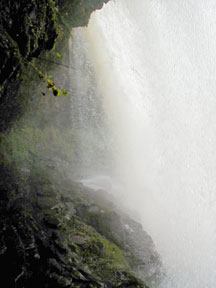
The guidebooks raved about the waterfall walk in Brecon Beacons National Park, southern Wales. Since the temperature was not too cool (about 57 degrees F) and we had our Gortex rain coats and pants, we decided to try the walk despite the threatening weather. This five mile forest loop has spurs out to three waterfalls, the last one of which you could actually walk under. Who can resist that? We headed to the park visitor center to talk to the ranger and get a reliable map. She said the main trail is muddy but passable. However, she did warn us to keep off the secondary trail that hovered closer to the river. This trail is steep, narrow, and slippery with 30 foot drops to the river on one side. They had already rescued several people from the secondary path this year. We honestly assured her that we had no intention of straying from the main path. Yeah, you guessed it; we missed the way back to the main trail and found ourselves where we shouldn’t have been. The problem was that by the time we realized that we were off the main trail, there was no going back. The “Dangerous, Slippery Cliffs” sign with the silhouette of a guy falling off of a cliff should have keyed us in earlier. We walked under some overhanging rock and passed a dead sheep. I started thinking “If a sheep can’t make it back, what the heck are we doing here?”
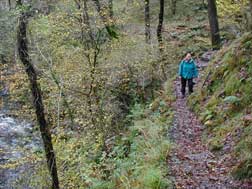 Just then it started pouring rain. We went back under the rock for protection (the sheep didn’t mind sharing) and thought about our next step (literally). We knew this path would join up with the main one eventually, but Di was getting really nervous about the situation. She is not known for her sure-footedness or grace even under dry and smooth conditions. When it stopped raining we resumed our careful stepping over the small streams, rocks and tree roots that were all over the path. Needless to say we eventually found the main path and safely finished the loop. Tim did get to walk under the waterfall and get happily soaked for his effort. Di skipped this part. She was already soaked with nervous sweat and too shaky-legged to risk a very cold swim. So much for earning a nature trail merit badge this trip.
Just then it started pouring rain. We went back under the rock for protection (the sheep didn’t mind sharing) and thought about our next step (literally). We knew this path would join up with the main one eventually, but Di was getting really nervous about the situation. She is not known for her sure-footedness or grace even under dry and smooth conditions. When it stopped raining we resumed our careful stepping over the small streams, rocks and tree roots that were all over the path. Needless to say we eventually found the main path and safely finished the loop. Tim did get to walk under the waterfall and get happily soaked for his effort. Di skipped this part. She was already soaked with nervous sweat and too shaky-legged to risk a very cold swim. So much for earning a nature trail merit badge this trip.
Another great day was spent in the National Botanical Garden Wales. We have been in Botanical Gardens started several hundred years ago (like Kew Gardens in London).
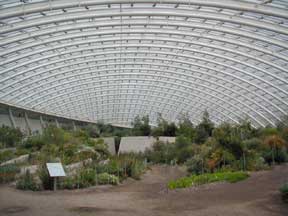 The Welsh Garden is only two years old and still being developed. As you drive through the countryside you can see in the distance a huge rounded glass house. It looks like a drop of water on the green landscape. This rounded glass house is devoted entirely to plants of the Mediterranean zone. This means, not only the actual Mediterranean but also Chile, Southern California, Western Australia, and the Canary Islands. It may seem like a strange group of plants to find in Wales but it allows the people to see plants most of them could not view otherwise (like the idea behind most zoos). Also, the National Garden serves as a place to study and try to propagate the endangered plants of those regions. As usual, it was raining that day. Unfortunately, most of the garden was outdoors. But we did tromp around looking at the gardens under development, the bog and water gardens (certainly well supplied with water), and some extraordinary water sculptures. It was interesting and humbling to see how much was growing after just two years. Although we love to visit gardens, it is usually frustrating as well. Di always finds some plants she would love to grow at home, but they would not survive in the snow, sand and shade of our garden. Ah well, there are always more hostas to plant!
The Welsh Garden is only two years old and still being developed. As you drive through the countryside you can see in the distance a huge rounded glass house. It looks like a drop of water on the green landscape. This rounded glass house is devoted entirely to plants of the Mediterranean zone. This means, not only the actual Mediterranean but also Chile, Southern California, Western Australia, and the Canary Islands. It may seem like a strange group of plants to find in Wales but it allows the people to see plants most of them could not view otherwise (like the idea behind most zoos). Also, the National Garden serves as a place to study and try to propagate the endangered plants of those regions. As usual, it was raining that day. Unfortunately, most of the garden was outdoors. But we did tromp around looking at the gardens under development, the bog and water gardens (certainly well supplied with water), and some extraordinary water sculptures. It was interesting and humbling to see how much was growing after just two years. Although we love to visit gardens, it is usually frustrating as well. Di always finds some plants she would love to grow at home, but they would not survive in the snow, sand and shade of our garden. Ah well, there are always more hostas to plant!
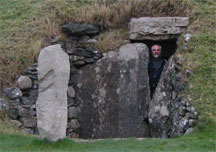
Wales was, despite the weather, a delightful surprise. The diversity of the landscapes were unexpected. The people were gracious with a wonderful dry wit. Although the country did not have the large numbers of cathedrals, abbeys, and ruins we had seen elsewhere, their little villages had the charm you thought would be gone as tourists came.
In general, this country is really underutilized by visitors, even from other parts of Britain.
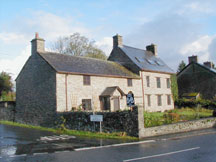 We would recommend Wales as a off-the beaten track but still accessible place to holiday.
We would recommend Wales as a off-the beaten track but still accessible place to holiday.
One of our last nights here was spent in a small town called Bronllys, staying in 400 year old house. The only place our hostess recommended to eat in the town was the Honey Café which served Tex Mex. Tim says the Welsh version of chimichungas were tasty. It is a small world, after all.
Hope you are all well. Until next time,
Di and Tim
 The “ll” is an “hl” which you kind of spray out (at least the foreigners do).
So try that on the following: Mynachlogddu, Ffwrwm, Lake Vyrnwy, Llaneglwys, Mynydd Myddfai, Pwllgolyw, Cymduad, and Penycym (we stayed in the last two). Welsh is supposedly a phonetic language (say what you see) but my problem is I keep seeing double! Not all of the Welsh town names were hard to pronounce. Some interesting ones were: Stepaside, Porthadog, Cheritan or Stackpole Elidor, Tavernspite, Felinde Farchog, and (for the mathematically inclined) Square & Compass.
The “ll” is an “hl” which you kind of spray out (at least the foreigners do).
So try that on the following: Mynachlogddu, Ffwrwm, Lake Vyrnwy, Llaneglwys, Mynydd Myddfai, Pwllgolyw, Cymduad, and Penycym (we stayed in the last two). Welsh is supposedly a phonetic language (say what you see) but my problem is I keep seeing double! Not all of the Welsh town names were hard to pronounce. Some interesting ones were: Stepaside, Porthadog, Cheritan or Stackpole Elidor, Tavernspite, Felinde Farchog, and (for the mathematically inclined) Square & Compass.

 We climbed (down) Mt. Snowdon (about three-fourths of the way) after taking a small train up. One could see valleys, rivers, and lakes below (see attached photo). This whole process was almost a bust. We arrived at 10:30 a.m. to find that the next available train wasn’t until 2 p.m. Since it was drizzling, we had no intention of climbing up the mountain. So we bought advance tickets and drove around some local villages to pass the time. Although we arrived 15 minutes early for the train, every passenger seat was taken (they had oversold the seats by two). They offered to refund our money but we were beyond indignant. We had spent the day essentially waiting for the train. After appealing to several levels of bureaucracy, we were allowed to sit in the front with the brakeman (the best seats on the train). To our surprise it stopped raining and the sun even shone for a few seconds while we walked. This walk was certainly worth the wait.
We climbed (down) Mt. Snowdon (about three-fourths of the way) after taking a small train up. One could see valleys, rivers, and lakes below (see attached photo). This whole process was almost a bust. We arrived at 10:30 a.m. to find that the next available train wasn’t until 2 p.m. Since it was drizzling, we had no intention of climbing up the mountain. So we bought advance tickets and drove around some local villages to pass the time. Although we arrived 15 minutes early for the train, every passenger seat was taken (they had oversold the seats by two). They offered to refund our money but we were beyond indignant. We had spent the day essentially waiting for the train. After appealing to several levels of bureaucracy, we were allowed to sit in the front with the brakeman (the best seats on the train). To our surprise it stopped raining and the sun even shone for a few seconds while we walked. This walk was certainly worth the wait.
 Knowing how unpredictable October weather can be, we tried to have alternative plans. This could include driving around, seeing museums and ruins with roofs, etc. One rainy day we toured a slate mine. The slate mined in Wales provided roofs for Europe until World War II and the advent of other roofing materials. A small train took us down into the mine where you could see how huge pieces of slate were blasted out and brought to the surface. Later we watched a slate splitter take an inch-thick piece and split it into eight thin sheets. So little actual usable slate results from this process that you can see sides of mountains covered with the slate wastes from the mines. When the mines closed, many villages were devastated and large groups of people emigrated.
Knowing how unpredictable October weather can be, we tried to have alternative plans. This could include driving around, seeing museums and ruins with roofs, etc. One rainy day we toured a slate mine. The slate mined in Wales provided roofs for Europe until World War II and the advent of other roofing materials. A small train took us down into the mine where you could see how huge pieces of slate were blasted out and brought to the surface. Later we watched a slate splitter take an inch-thick piece and split it into eight thin sheets. So little actual usable slate results from this process that you can see sides of mountains covered with the slate wastes from the mines. When the mines closed, many villages were devastated and large groups of people emigrated.


 Just then it started pouring rain. We went back under the rock for protection (the sheep didn’t mind sharing) and thought about our next step (literally). We knew this path would join up with the main one eventually, but Di was getting really nervous about the situation. She is not known for her sure-footedness or grace even under dry and smooth conditions. When it stopped raining we resumed our careful stepping over the small streams, rocks and tree roots that were all over the path. Needless to say we eventually found the main path and safely finished the loop. Tim did get to walk under the waterfall and get happily soaked for his effort. Di skipped this part. She was already soaked with nervous sweat and too shaky-legged to risk a very cold swim. So much for earning a nature trail merit badge this trip.
Just then it started pouring rain. We went back under the rock for protection (the sheep didn’t mind sharing) and thought about our next step (literally). We knew this path would join up with the main one eventually, but Di was getting really nervous about the situation. She is not known for her sure-footedness or grace even under dry and smooth conditions. When it stopped raining we resumed our careful stepping over the small streams, rocks and tree roots that were all over the path. Needless to say we eventually found the main path and safely finished the loop. Tim did get to walk under the waterfall and get happily soaked for his effort. Di skipped this part. She was already soaked with nervous sweat and too shaky-legged to risk a very cold swim. So much for earning a nature trail merit badge this trip.
 The Welsh Garden is only two years old and still being developed. As you drive through the countryside you can see in the distance a huge rounded glass house. It looks like a drop of water on the green landscape. This rounded glass house is devoted entirely to plants of the Mediterranean zone. This means, not only the actual Mediterranean but also Chile, Southern California, Western Australia, and the Canary Islands. It may seem like a strange group of plants to find in Wales but it allows the people to see plants most of them could not view otherwise (like the idea behind most zoos). Also, the National Garden serves as a place to study and try to propagate the endangered plants of those regions. As usual, it was raining that day. Unfortunately, most of the garden was outdoors. But we did tromp around looking at the gardens under development, the bog and water gardens (certainly well supplied with water), and some extraordinary water sculptures. It was interesting and humbling to see how much was growing after just two years. Although we love to visit gardens, it is usually frustrating as well. Di always finds some plants she would love to grow at home, but they would not survive in the snow, sand and shade of our garden. Ah well, there are always more hostas to plant!
The Welsh Garden is only two years old and still being developed. As you drive through the countryside you can see in the distance a huge rounded glass house. It looks like a drop of water on the green landscape. This rounded glass house is devoted entirely to plants of the Mediterranean zone. This means, not only the actual Mediterranean but also Chile, Southern California, Western Australia, and the Canary Islands. It may seem like a strange group of plants to find in Wales but it allows the people to see plants most of them could not view otherwise (like the idea behind most zoos). Also, the National Garden serves as a place to study and try to propagate the endangered plants of those regions. As usual, it was raining that day. Unfortunately, most of the garden was outdoors. But we did tromp around looking at the gardens under development, the bog and water gardens (certainly well supplied with water), and some extraordinary water sculptures. It was interesting and humbling to see how much was growing after just two years. Although we love to visit gardens, it is usually frustrating as well. Di always finds some plants she would love to grow at home, but they would not survive in the snow, sand and shade of our garden. Ah well, there are always more hostas to plant!

 We would recommend Wales as a off-the beaten track but still accessible place to holiday.
We would recommend Wales as a off-the beaten track but still accessible place to holiday.